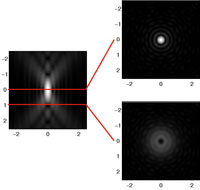Fitting of 3D-PSF models to fluorescent microbead stacks
2007
Master Diploma
Project: 00160

To understand cellular processes down to molecular scales, modern biological research greatly depends on optical microscopy. However, in some cases, even advanced instrumentation (e.g. confocal or multiphoton microscopes) may not provide sufficient resolution; this calls for post-acquisition image-enhancement operations, such as image deconvolution.
Commercial deconvolution packages are available, but their quality is often limited by the poor characterization of the imaging system. In practice, biologists have to choose between:
- an analytical PSF model that is noise-free but poorly matches the physical reality;
- a measured PSF that is closer to the experimental conditions but corrupted by noise.
We propose to design an algorithm that would fit an analytical PSF model to a 3D stack of fluorescent microbeads, hence providing a compromise between theory and real life. We will first consider a generic PSF model (Zernike coefficients); then we will adapt it to more specific situations (Gibson & Lanny model). The project includes adapting a fast (precompiled) module for computing PSF sections. The initial development and validation will be performed on Matlab; later a user-friendly ImageJ plugin will be considered.
Commercial deconvolution packages are available, but their quality is often limited by the poor characterization of the imaging system. In practice, biologists have to choose between:
- an analytical PSF model that is noise-free but poorly matches the physical reality;
- a measured PSF that is closer to the experimental conditions but corrupted by noise.
We propose to design an algorithm that would fit an analytical PSF model to a 3D stack of fluorescent microbeads, hence providing a compromise between theory and real life. We will first consider a generic PSF model (Zernike coefficients); then we will adapt it to more specific situations (Gibson & Lanny model). The project includes adapting a fast (precompiled) module for computing PSF sections. The initial development and validation will be performed on Matlab; later a user-friendly ImageJ plugin will be considered.
- Supervisors
- Cédric Vonesch, cedric.vonesch@epfl.ch, 021 693 51 43, BM 4.141
- Michael Unser, michael.unser@epfl.ch, 021 693 51 75, BM 4.136